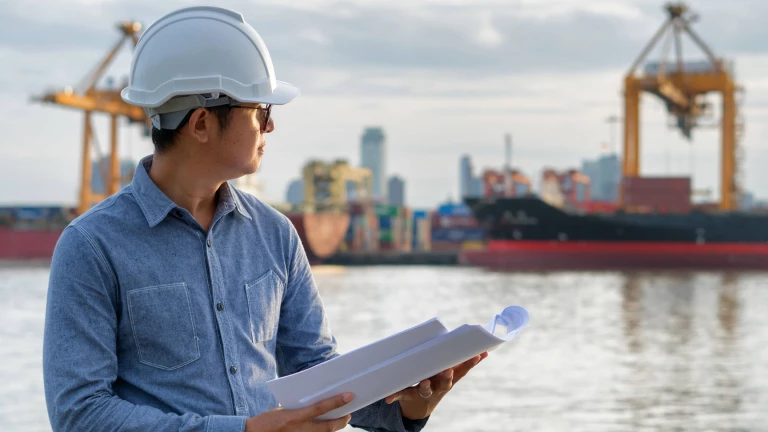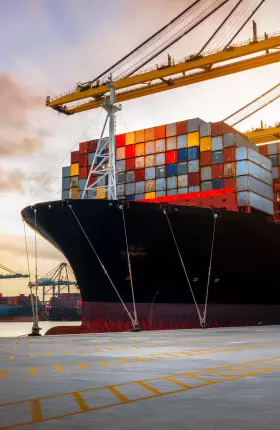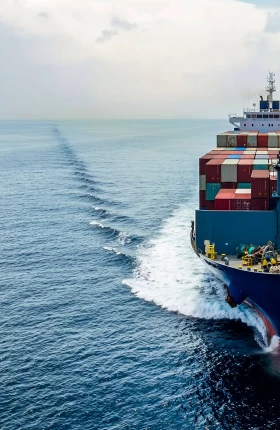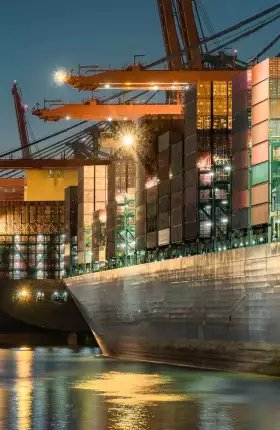As you craft a decarbonization strategy—for today and tomorrow—here are seven crucial areas to consider.
Most shipping companies accept that they will need to curb emissions to safeguard their future in a low-carbon world—but they are facing a difficult transition dilemma. Current regulation in the shipping industry aims to halve maritime emissions by 2050 but stops short of targeting net zero by then. And while there are steps players can take to reduce fuel emissions, alternative hydrogen-based options such as ammonia and methanol are still at an early stage. It’s not surprising that companies are asking: Should we embark on the net-zero journey now or hold off until the regulatory and technology pathway is clearer?
Companies that forge ahead today will gain multiple tangible advantages. By committing to net zero and taking ambitious steps to hit this goal, players can benefit from improved brand perception, better customer attraction and retention, and greater financing opportunities. And by taking action now, they can also drive the creation of effective solutions and help influence legislation during the coming years, thereby securing a competitive advantage over rivals.
To start decarbonizing, shipping companies must make tough decisions on investments, technologies, and collaborative partnerships. In an uncertain environment, companies require a strategy that will strengthen their businesses today but will also position them for future developments, such as the emergence of alternative fuels and the prospect of tougher regulations.
Proactive shipping players need to develop a strategy for transitioning to a low-carbon world. At its heart, this involves building a low-carbon business, climate-proofing operations, and engaging transparently with stakeholders. (See “How a Decarbonization Plan Creates Shareholder Value.”)
HOW A DECARBONIZATION PLAN CREATES SHAREHOLDER VALUE
- Develop a low-carbon business. By understanding their current trajectory on the net-zero journey as well as different climate scenarios and related risks, companies can identify opportunities for a revenue-enhancing low-carbon business.
- Climate-proof operations. Companies should aim to reduce emissions from their operations, engage in sustainable sourcing so that they address their carbon footprint holistically, and manage the physical risks posed by climate change.
- Engage transparently with stakeholders. It is essential that companies are open about their climate journey and communicate with external stakeholders. They should actively work with regulators, the public, and other players in the value chain to foster support for decarbonization and justify the risk-return reward.
But to create a truly effective transition strategy, companies must first understand the risks and opportunities in seven crucial areas: customer demand, regulation, and financing (decarbonization drivers); operational efficiency, technological efficiency, and future fuels (transition levers); and ecosystem collaborations. (See Exhibit 1.)
Decarbonization Drivers
Three main forces are driving the shift toward decarbonization in shipping.
Customer Demand
Shipping customers face mounting pressure to curb Scope 3 emissions (resulting from assets that these companies do not own directly) in their supply chains, including from marine transportation, and they are prepared to pay. In a BCG survey of 125 companies that rely on shipping, 71% of respondents said they would pay a premium for carbon-neutral shipping, and 63% of respondents expected they would be more willing to pay a premium within the next five years. (See Exhibit 2.) In addition, 67% would be more loyal to (less inclined to switch from) a carbon-neutral shipping company.
Our survey found that, on average, customers are willing to pay a premium of 2% today for carbon-neutral shipping. But we estimate that a premium of 10% to 15% over current rates would be needed to fund the industry’s transition to net-zero emissions by 2050. This suggests that, given customers’ existing willingness to pay more, they could contribute to the industry’s transition costs, but other measures, including subsidies and additional funding sources, would be required to meet the expense.
We also discovered that shipping customers have different motives for wanting carbon-neutral shipping. Most are driven by the expectation of tougher emissions legislation (58%). But demands from their own customers (29%) and pressure from investors and lenders (11%) are also important factors.
At the same time, companies’ willingness to pay a premium differs significantly by sector. For example, some 93% of basic-materials companies—which face high and hard-to-abate emissions—are ready to pay more, with an average increase of 4% over current rates.
- Stand out from the pack with clear targets. By being open about their decarbonization efforts, companies can encourage consumers to view their business as a safe environmental choice. Better transparency will also help players differentiate themselves from rivals as carbon-neutral operations become table stakes for the industry.
- Take a differentiated approach to customers. Shipping players can use insights about “climate pioneers” (companies that are willing to pay higher rates than others because they believe using low-carbon transportation services will give them a competitive edge) and “compliance seekers” (which are prepared to pay only what they must to meet industry regulations) to their advantage by taking a different approach with each customer group. For example, players could offer a climate pioneer, such as a retail brand, its own carbon-neutral shipping in exchange for guaranteed volumes.
- Move beyond transactional relationships. By partnering with customers to help decarbonize their supply chains, shipping players can create greater loyalty and be seen as more than merely a commodity service. They should especially target companies in hard-to-abate, high-emission industries, such as basic materials and technology, because these are likely to be impacted the most by stricter environmental regulations and therefore have the greatest incentive to partner and invest.
Regulation
Shipping companies face a highly uncertain regulatory environment. So far, the International Maritime Organization (IMO) has drawn up measures to reduce total industry emissions by at least 50% by 2050 and cut the average carbon intensity of global shipping operations by at least 40% by 2030 and 70% before mid-century. But these measures stop short of setting the industry on a path to net-zero emissions by 2050.
Shipping companies, governments, and NGOs are pushing for a more ambitious approach. These include proposals from Maersk for a $450 tax on every ton of bunker fuel to encourage investment in alternative fuels. In July 2021, the European Commission announced a package of policy proposals, called Fit for 55, to slash emissions by at least 55% by 2030 (from 1990 levels). This legislation would have significant implications for the shipping industry:
- The shipping sector, for the first time, would be added to the scope of the EU Emissions Trading System (ETS); this would require vessel operators to purchase allowances for emissions produced by voyages into and out of European ports. Additionally, carbon prices would be raised and the emissions cap would be tightened to align with the 2030 target.
- The FuelEU Maritime initiative, introduced by the European Commission, would promote the use of low-carbon marine fuels by imposing a limit on the emissions intensity of fuel used by ships calling at EU ports, assessed on a well-to-wake basis (covering the lifetime emissions of the fuel).
While the Fit for 55 package still needs approval from EU member states and the European Parliament, it underlines that there is a strong regulatory push in some quarters for the shipping industry to make a step change. Companies need to be proactive in implementing further efficiency measures and adopting low-carbon fuel if they are to avoid potential regulatory pitfalls and rising costs.
- Reduce uncertainty by setting ambitious emissions reduction targets. Companies should establish bold fact-based goals that cut emissions quickly in the short term. Doing so will help sidestep the danger of future penalties or taxes, costly retrofitting to meet new standards, or—in the worst-case scenario—stranded assets.
- Design your targets after assessing potential future scenarios. Model the impact of possible developments, such as tough new regulations, on company operations. Mitigate the highest-risk scenarios by taking timely action.
Financing
An estimated $2.4 trillion in funding will be needed for shipping to achieve net-zero emissions by 2050. The bulk of this amount—approximately $1.7 trillion—will go toward alternative, or future, fuels. Of this, the energy and chemical industries will require an investment of about $1.5 trillion for producing hydrogen feedstock and for fuel synthesis, storage, and distribution facilities. (See Exhibit 3.) Players in these sectors will likely recoup their investment by charging shipping companies higher refueling fees. Shipping players will have to spend approximately $0.2 trillion of the $1.7 trillion on new engines and onboard storage solutions. And on top of the alternative-fuel costs, they will need to invest about $0.7 trillion in operational and technological efficiencies.
Commercial bank loans have traditionally been shipping’s main form of financing. For the industry to reach net zero, however, the public sector will need to take a more active role in facilitating investment, through direct subsidies or blended finance instruments that encourage private sector participation. A growing variety of investors—including institutions, venture capitalists, and high-net-worth individuals—will also play a part in funding the industry.
The rise of environmental, social, and governance (ESG) finance is already adding to the pressure on shipping companies to decarbonize. The Poseidon Principles, an industry framework encouraging lenders to incorporate climate considerations into their decisions, currently has 27 signatories representing nearly half of the global lending to shipping companies. In response, companies will need clear and effective decarbonization plans.
- Ensure your climate-proofing plan is demanding and transparent. An effective strategy must set clear, ambitious emissions reduction targets and manage the costs and risks arising from the transition to net zero if it is to convince potential investors and lenders. It must also engage the whole organization by establishing measurement baselines and linking goals to incentives and accountability. Equally important, it should promote transparency and ensure that progress is properly communicated to external stakeholders.
- Form partnerships with other sectors to unlock financing. Collaborations between shipping companies and other players along the value chain—including energy and chemical firms—can open new pools of financing by demonstrating a broad sector-wide commitment and signaling to investors that there is a strong business case for the future. These partnerships can be leveraged to access investment for future-fuel development and infrastructure.
- Explore alternative financing mechanisms. Companies can also find new funding sources by using nontraditional financing mechanisms. These include risk- and benefit-sharing arrangements with suppliers and blended financing mechanisms, such as the European Investment Bank’s green-shipping financing program.
Transition Levers
Once they’ve assessed the impact of decarbonization drivers on their business, shipping companies should turn to transition levers. These will enable them to start reducing emissions.
According to the IMO, two levers—operational- and technological-efficiency improvements—have lowered carbon emissions per transported unit by 20% to 30% since 2008 and could cut them by a further 20% to 25% by 2050. Clearly, while the benefits from efficiency improvements are significant, zero-emission fuels (future fuels) will also be essential if the industry is to achieve net zero in time.
Operational Efficiency
Optimizing company operations involves the application of onshore computer systems and digital technologies, including machine learning and internet-connected sensors. These can be used to prolong the life of assets and improve routing, fuel efficiency, and cargo distribution.
Reducing the consumption of bunker fuel is often a key objective with operational-efficiency measures. Because fuel reductions save cash, as well as curbing emissions, these investments have the potential to finance themselves. And given that operational-efficiency investments are generally made onshore, they are not affected by decisions to retrofit vessels or acquire new ones. Consequently, shipping players should view operational-efficiency measures as a no-regret move today.
- Take a proactive approach. Use digital technologies to optimize the business commercially (by identifying the best vessel routing and optimal speeds) and for capacity (by reducing empty or half-filled containers on return journeys).
- Don’t ignore asset optimization. Companies should invest in solutions that improve maintenance and prolong asset life by analyzing data from ship-based sensors. They should also consider creating digital twins, which enable faster, better decisions by replicating equipment in a virtual environment.
- Build or buy digital capabilities on the basis of size. For large companies, it makes sense to dedicate internal resources to developing a digital capability. Smaller players will need to purchase solutions from external providers to remain cost competitive.
Technological Efficiency
These improvements can be made using onboard technologies that curb emissions by boosting a vessel’s energy efficiency or decreasing bunker fuel consumption in other ways. Several alternatives exist, including new propulsion systems, drag reduction measures, and technologies that enhance existing power and propulsion systems. The maturity levels of these technologies vary widely, however. Nascent technologies, such as air lubrication and waste heat recovery, have yet to demonstrate their full potential. Shipping companies need to factor such maturity differences into their plans.
- Deploy mature or nearly mature technologies early. Players should focus on technologies that are available today, or soon will be, and can deliver an immediate impact. They should start by investing in drag reduction measures, such as hull coating and trim optimization. These are relatively inexpensive measures for the emissions decreases they achieve.
- Align your new build program with emerging technologies. To prepare for longer-term solutions, shipping companies should participate in collaborative R&D partnerships with shipyards and other ecosystem members so that they are part of the development process. By doing this, they can benefit from greater scale and better resource allocation and can share ideas.
Future Fuels
Alternative fuels are essential for the industry to reach net zero by 2050. Major structural changes will be required to enable their adoption, however. New vessels with engines capable of running on zero-emission fuels will have to be designed and built, and existing ships will need retrofitting. Indeed, commercially viable zero-emission vessels must start entering the global fleet by 2030 to hit the net-zero goal. For all this to happen, alternative-fuel production facilities and bunkering infrastructure will need to be in place.
Clearly, a convergence around future-fuel winners is an important starting point. We expect a tapestry of leaders to emerge, depending on factors such as vessel type and geographic area. Biofuel is available to use today for blending with conventional fuels. But scalability issues and relatively high emissions mean that it will likely be a short-term solution.
For short-haul vessels, electricity is emerging as a viable longer-term option, while for long-haul vessels, the industry appears to be converging around hydrogen-based fuels such as ammonia and methanol. Ammonia looks particularly promising in the long run because of its zero-emission potential, expected lower costs than methanol, and ease of scaling. (See Exhibit 4.)
Given the long lifetime of vessels (typically 20 to 25 years), ship engines commissioned today will need to run on zero-emission fuels as we approach 2050. Some companies are postponing new-vessel orders until zero-emission engine technology becomes available. But not all players have that option. For some, the ease of retrofitting existing engines and fuel flexibility are important considerations if they are to achieve net zero and avoid stranded assets.
On long-haul vessels, dual-fuel engines can run on either conventional fuel or alternatives such as liquified natural gas. Most engines switch seamlessly, using two separate fuel tanks, without losing power output. This ability to use lower-emission fuels rather than bunker fuel could be valuable as decarbonization pressures mount and while zero-emission fuels remain unviable.
Retrofitting dual-fuel engines is also cheaper than it is for traditional ones. We estimate that retrofitting a traditional engine so that it also runs on ammonia would cost up to $10 million, compared with about $1 million to $2 million for dual-fuel alternatives. Before deciding on the right engine for a new-build vessel, however, companies should take a holistic approach and factor in capex, opex, and revenue considerations. They need to weigh up the engine acquisition cost, retrofitting expenditures, the probability of a retrofit option being available, potential fuel price changes, any opportunity cost from lost cargo space, and the impact on customer demand.
- Investigate short-term options to blend in lower-emission fuels. Assess opportunities to decrease fossil fuel consumption through blending. Fuel availability and cost are important factors in determining whether this approach will work across the fleet.
- Contribute to zero-emission fuel development if possible. Provided they have sufficient capabilities, companies should identify capex-efficient ways of helping to develop zero-emission fuels. They should collaborate with other players and launch pilot projects to learn about fuel technologies and usage.
- Prioritize dual-fuel engines for new long-haul vessels but do so on a ship-by-ship basis. In the near term, companies should broadly focus on dual-fuel engines for new-build long-haul vessels and investigate electric-power and hybrid systems (combining batteries with conventional engines) for short-haul vessels. But because there is no one-size-fits-all approach to asset replacement, they should consider each vessel holistically and on a case-by-case basis.
Ecosystem Collaborations
Shipping is a large, fragmented ecosystem. The industry must use the strengths and resources of multiple participants to its advantage in tackling decarbonization. Players should form collaborative projects throughout the value chain to develop future fuels, create new approaches that unlock financing, and build different types of customer partnerships.
- Collaborate in areas that make a difference. Form or join alliances that will have a tangible effect on companies’ decarbonization efforts, either by lowering emissions intensity in the existing fleet or ensuring the adoption of more zero-emission vessels.
Make Your Business Climate-Ready
Shipping companies should move quickly to adopt measures and strategies that effectively tackle decarbonization. Guided by the considerations set out above, they should take these essential actions:
- Perform a rapid health check that analyzes the state of the business on the basis of our decarbonization drivers, transition levers, and the potential for ecosystem collaboration.
- Define a net-zero ambition and strategy, including bold, fact-based emissions reduction targets and an achievable plan of attack.
- Start climate-proofing company operations through operational- and technological-efficiency improvements and manage the fleet according to an assessment of future-fuel options.
- Engage the full ecosystem by participating in collaborative platforms.
The business imperative for climate action is clear. It is no longer a question of whether or why shipping companies should decarbonize but how. While the pathway to net zero remains complicated, it is rapidly becoming more defined. Company leaders must seize the initiative and begin the journey today. Otherwise, they risk missing out on fresh commercial opportunities or being forced to play catch-up as customers and regulators impose new environmentally friendly demands and requirements.










